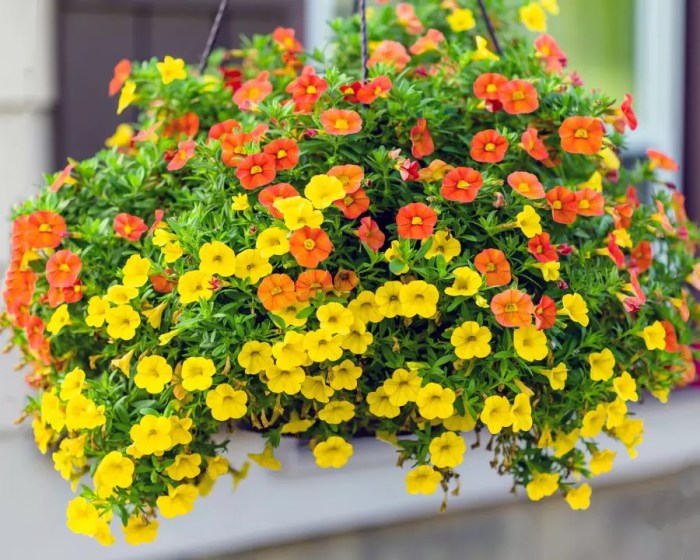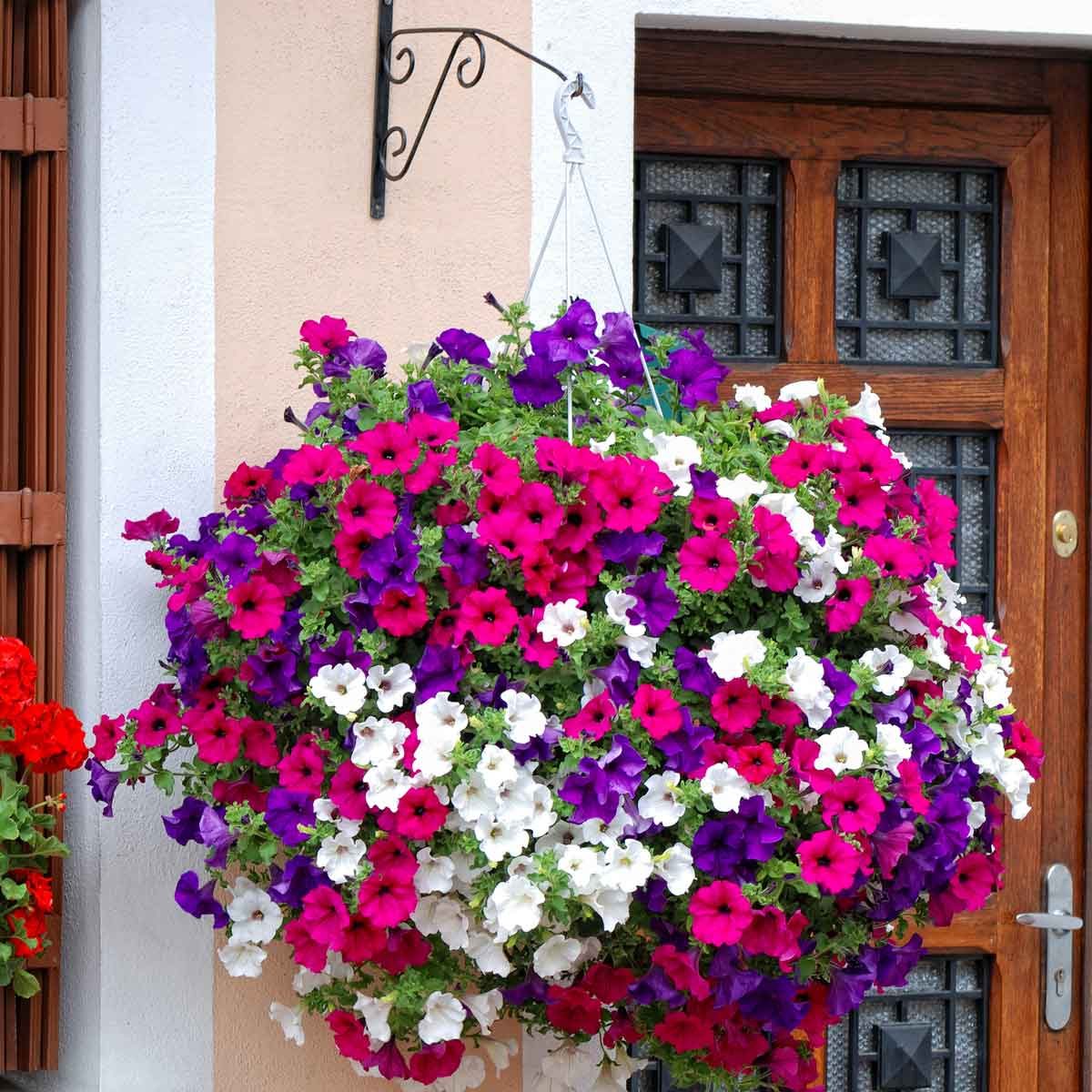Easy maintenance hanging plants are a delightful addition to any home, offering a touch of greenery and vertical beauty with minimal effort. Whether you’re a seasoned plant enthusiast or a novice gardener, these low-maintenance wonders are a perfect choice to bring life and style to your indoor spaces.
From low-light tolerant varieties to water-wise options, easy maintenance hanging plants cater to various needs and preferences. Their adaptability makes them ideal for busy individuals, shaded areas, and even those with limited gardening experience.
Low-Light Tolerant Varieties
Low-light tolerant plants are ideal for hanging baskets in shaded areas, as they can thrive with minimal sunlight. These plants are perfect for adding greenery to north-facing balconies, indoor rooms with limited natural light, or covered patios.
Popular Low-Light Hanging Plants
Some popular low-light hanging plants include:
- Spider Plant (Chlorophytum comosum):Prefers bright indirect light but can tolerate low light. Known for its long, cascading leaves with white stripes.
- Snake Plant (Sansevieria trifasciata):Extremely low-light tolerant, making it ideal for dimly lit areas. Features upright, sword-shaped leaves with green or variegated patterns.
- ZZ Plant (Zamioculcas zamiifolia):Also known as the Zanzibar Gem, it can survive in very low light conditions. Has glossy, dark green leaves that are drought-tolerant.
- Pothos (Epipremnum aureum):A trailing vine that tolerates low light and can brighten up shady corners. Comes in various leaf shapes and colors, including variegated and solid green varieties.
- Peace Lily (Spathiphyllum wallisii):Prefers bright indirect light but can tolerate low light. Produces white or green flowers that resemble calla lilies.
Water-Wise Options
For those with busy schedules or limited watering availability, drought-tolerant hanging plants offer a convenient and attractive solution. These plants can thrive with infrequent watering, making them ideal for forgetful plant parents or those who travel frequently.
Here’s a table comparing different water-wise hanging plants, including their watering frequency and tolerance to dry conditions:
Water-Wise Hanging Plants
| Plant | Watering Frequency | Dry Conditions Tolerance |
|---|---|---|
| Spider Plant | Every 1-2 weeks | Moderate |
| Snake Plant | Every 2-4 weeks | High |
| Pothos | Every 1-2 weeks | Moderate |
| ZZ Plant | Every 3-4 weeks | High |
| Hoya | Every 2-3 weeks | Moderate |
Easy Propagation Methods

Propagating hanging plants is an excellent way to increase your collection and share your favorites with others. There are several methods for propagating hanging plants, including stem cuttings, division, and air layering. Each method has its advantages and disadvantages, so it’s important to choose the one that’s best for the plant you’re trying to propagate.
No matter which method you choose, it’s important to start with healthy plants. Take cuttings from plants that are actively growing and free of pests and diseases. Use clean, sharp tools to make your cuts, and be sure to sterilize your tools between cuts to prevent the spread of disease.
Easy maintenance hanging plants are a great way to add life to any room. If you’re looking for a plant that will add a touch of elegance to your space, consider a draping shelf plant . These plants are perfect for adding a touch of greenery to your shelves or mantle.
They’re also relatively easy to care for, making them a great choice for busy people or those who don’t have a lot of experience with plants. Plus, they can help to purify the air in your home.
Stem Cuttings
Stem cuttings are the most common method of propagating hanging plants. To take a stem cutting, simply cut a piece of stem from the plant, just below a node. The node is the point where the leaf attaches to the stem.
Once you have taken a cutting, remove the leaves from the bottom inch or two of the stem. This will help to prevent the cutting from rotting.
The next step is to root the cutting. You can do this by placing the cutting in a glass of water or by planting it in a pot of moist potting mix. If you’re rooting the cutting in water, be sure to change the water every few days to prevent it from becoming stagnant.
If you’re planting the cutting in potting mix, keep the mix moist but not soggy.
Easy maintenance hanging plants are a great way to add some greenery to your home without having to worry about a lot of upkeep. If you’re looking for something a little more low-maintenance, you might want to consider easy care trailing house plants . These plants are perfect for hanging baskets or pots, and they don’t require a lot of water or sunlight to thrive.
They’re also a great way to add some color and life to a room.
Once the cutting has developed roots, you can transplant it into a larger pot. Be sure to use a well-draining potting mix, and water the plant regularly.
Division, Easy maintenance hanging plants
Division is another easy way to propagate hanging plants. This method is best for plants that form clumps or rosettes. To divide a plant, simply dig it up and carefully separate the clumps or rosettes. Each clump or rosette can be planted in its own pot.
Air Layering
Air layering is a more advanced method of propagation, but it can be used to propagate plants that are difficult to root from stem cuttings. To air layer a plant, you will need to make a cut in the stem, just below a node.
The cut should be about 1 inch long and 1/2 inch deep. Once you have made the cut, insert a toothpick or small piece of wood into the cut to keep it open.
Next, wrap the cut area with moist sphagnum moss. The sphagnum moss should be kept moist at all times. After a few weeks, roots will begin to form in the sphagnum moss. Once the roots are well-developed, you can cut the stem below the roots and plant the new plant in a pot.
Pest and Disease Resistance

Hanging plants, with their limited access to soil, face unique challenges in pest and disease management. Their elevated position can make it difficult for them to absorb nutrients from the soil, weakening their immune systems and making them more susceptible to infestations and infections.
Choosing hanging plants with natural pest and disease resistance is crucial for maintaining their health and beauty. These plants have evolved defense mechanisms that help them fend off common threats, reducing the need for chemical treatments and ensuring their long-term well-being.
Pest Resistant Varieties
- Spider Plant (Chlorophytum comosum): Known for its long, arching leaves, spider plants naturally repel aphids, mealybugs, and other common pests.
- Boston Fern (Nephrolepis exaltata): This popular hanging fern is resistant to spider mites, whiteflies, and scale insects, thanks to its dense foliage and natural pest-repellent compounds.
- Pothos (Epipremnum aureum): A versatile and easy-care hanging plant, pothos is resistant to a wide range of pests, including aphids, mealybugs, and spider mites.
- Golden Pothos (Epipremnum aureum‘Golden’) : A cultivar of pothos, golden pothos inherits the pest resistance of its parent plant and adds a touch of color to hanging arrangements.
- Philodendron (Philodendron spp.): Many species of philodendron, such as Philodendron scandensand Philodendron hederaceum, are known for their resistance to pests like aphids, mealybugs, and scale insects.
Disease Resistant Varieties
- Cast Iron Plant (Aspidistra elatior): This hardy plant is resistant to a variety of fungal diseases, including leaf spot, powdery mildew, and root rot.
- Snake Plant (Sansevieria trifasciata): Snake plants are known for their tolerance to neglect and resistance to diseases like root rot, leaf spot, and bacterial soft rot.
- ZZ Plant (Zamioculcas zamiifolia): ZZ plants are highly resistant to pests and diseases, making them ideal for low-maintenance hanging arrangements.
- Prayer Plant (Maranta leuconeura): Prayer plants are generally resistant to diseases, but they are susceptible to spider mites if kept in dry conditions.
- Peperomia (Peperomia spp.): Many species of peperomia, such as Peperomia obtusifoliaand Peperomia caperata, are known for their resistance to diseases like leaf spot and powdery mildew.
Aesthetics and Design Considerations

Hanging plants are a captivating addition to any indoor space, offering both aesthetic appeal and functional benefits. Their ability to utilize vertical space makes them ideal for small apartments, entryways, or rooms with limited floor space.
Hanging plants are a great way to add some greenery to your home without taking up too much space. And if you’re looking for plants that are easy to care for, there are plenty of options to choose from. Some of the easiest indoor hanging plants include pothos, spider plants, and philodendrons.
These plants are all tolerant of neglect, so they’re perfect for those who don’t have a lot of time to care for their plants. For more information on the easiest indoor hanging plants, check out this article . You’re sure to find the perfect plant for your home.
When choosing hanging plants, consider the overall design style of your room. For a modern or minimalist aesthetic, opt for plants with clean lines and simple foliage, such as pothos or snake plants. For a bohemian or eclectic style, embrace trailing plants like spider plants or ferns, which add a touch of whimsy and texture.
Visual Interest
Hanging plants create visual interest by adding height and depth to a room. They draw the eye upward, making the space feel more spacious and inviting. Consider grouping plants of different sizes and shapes to create a dynamic display. Trailing plants can be used to soften sharp edges or create a cascading effect.
Ending Remarks
Incorporating easy maintenance hanging plants into your home decor not only enhances aesthetics but also purifies the air and promotes a sense of well-being. Their versatility allows for endless design possibilities, making them a valuable asset to any indoor space.
Question Bank: Easy Maintenance Hanging Plants
Q: What are some popular low-light tolerant hanging plants?
A: Peace lily, snake plant, ZZ plant, and pothos are excellent low-light hanging plants.
Q: How often should I water water-wise hanging plants?
A: Water-wise hanging plants, such as succulents and air plants, require infrequent watering, typically once every 2-4 weeks or even less.
Q: Can I propagate hanging plants easily?
A: Yes, many hanging plants can be easily propagated through stem cuttings, division, or air layering, making it possible to create multiple plants from a single one.